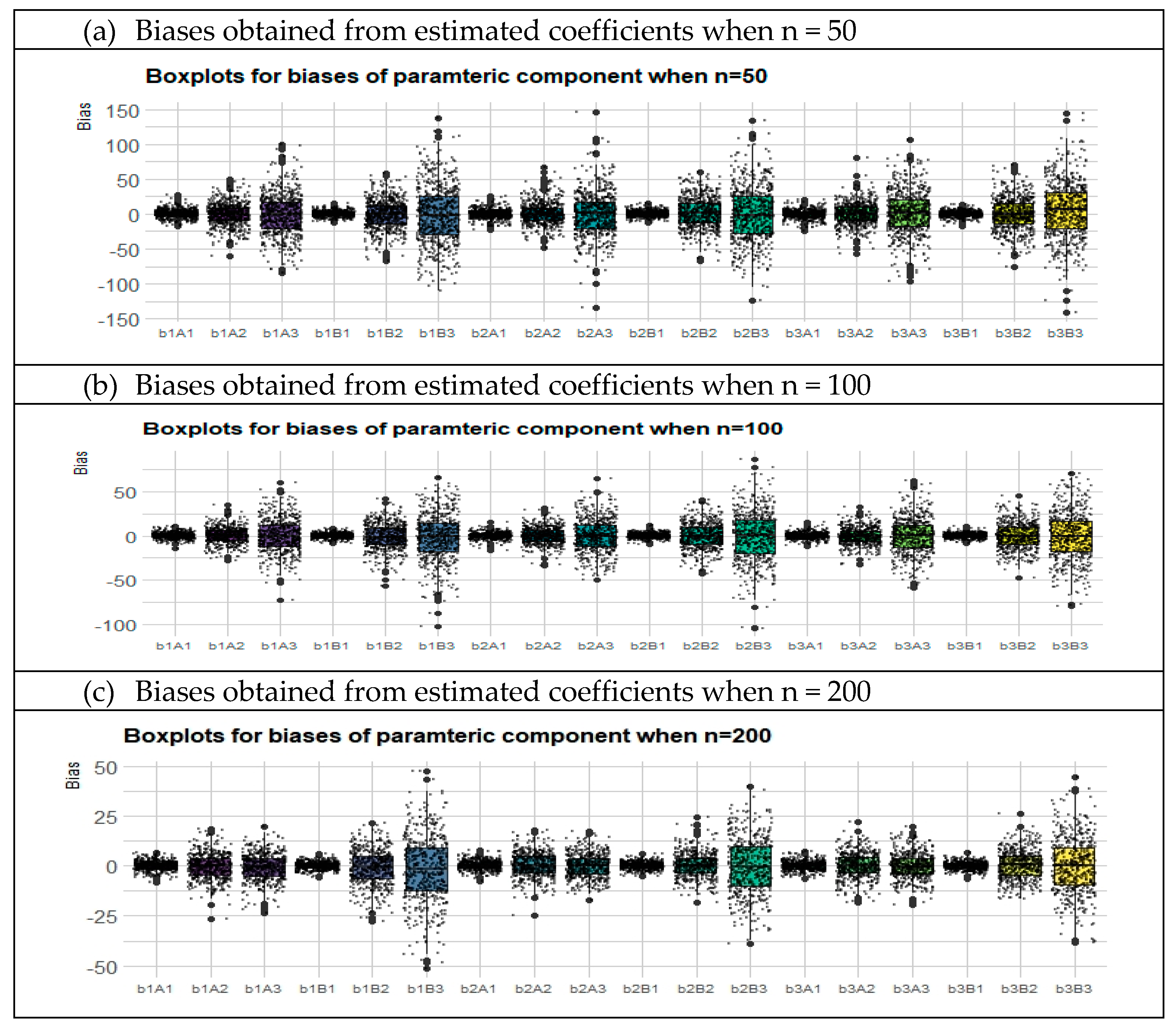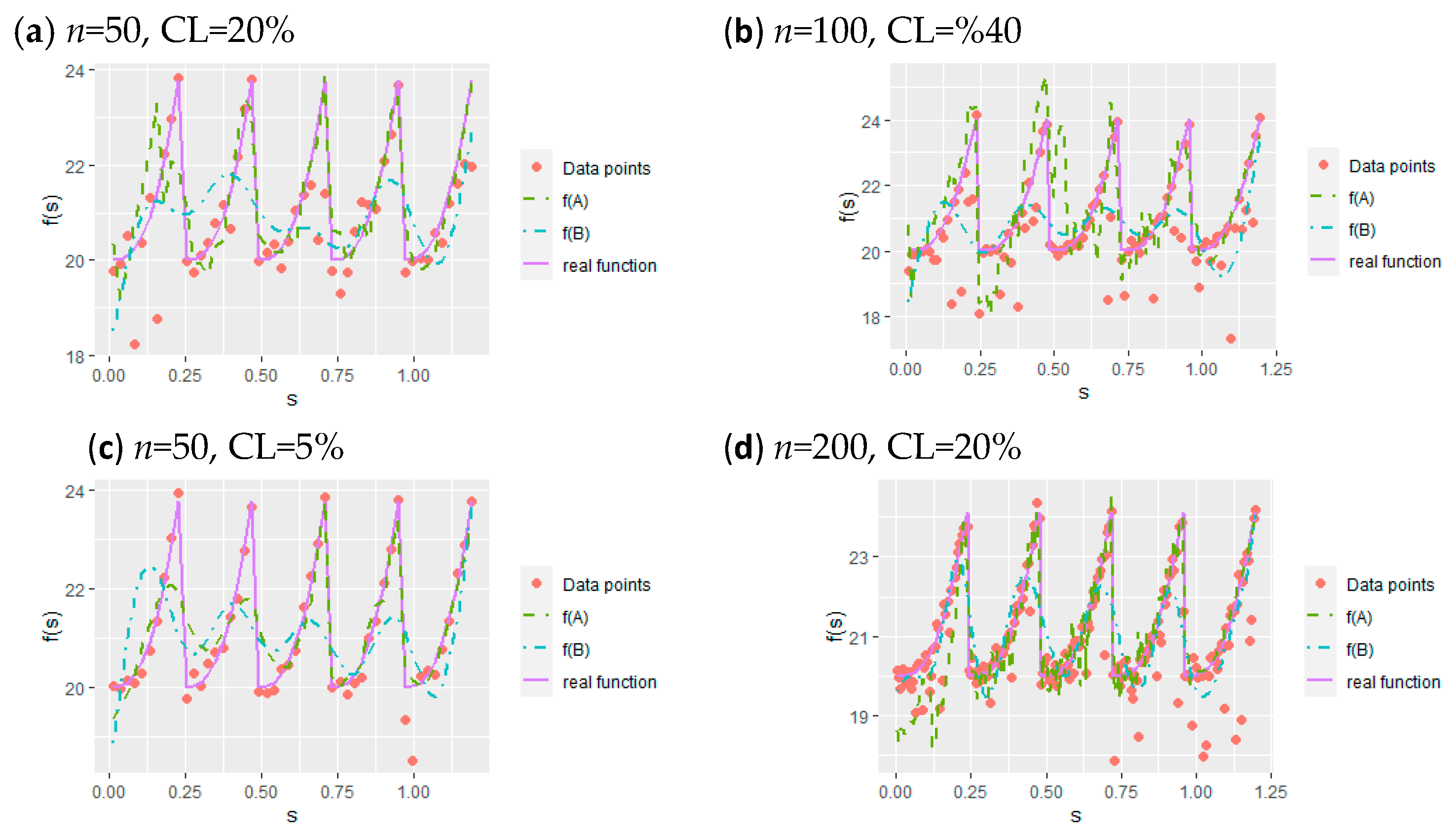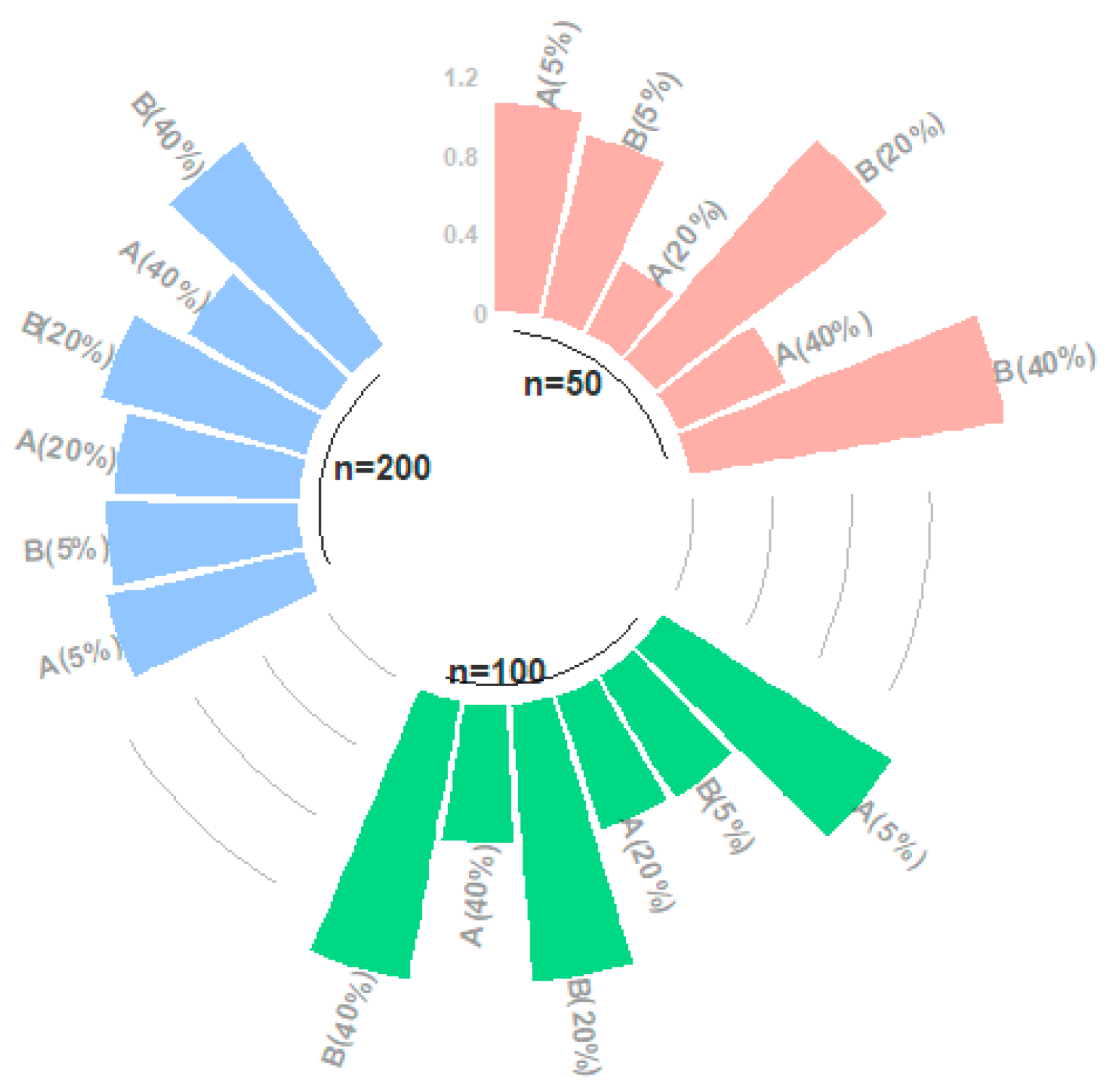We first introduce the BS considered for estimating the components of model (1). A univariate B-spline is constructed by a piecewise polynomial function of degree such that its derivatives up to order () is continuous at each knot point The set of BSs of degree over the real numbers is a vector space of dimension . In addition, note that denotes the number of interior knots, while indicates the polynomial order. For example, the polynomials of order are defined as constant, linear, quadratic, and cubic BS basis functions, respectively. If the knots are equally spaced (i.e., separated by same distance )), the knot points and the corresponding BSs are called uniform.
Definition 1. Given an ordered knot vectorin the domain of covariate, thenBS basis functionsof degreeandcan be defined in recursive series, respectively, as: Note that if the denominator of Equation (9) is equal to zero, then the BS basis function is assumed to be zero. From Equations (8) and (9), a set ofbasis functions have the following important properties:
(a) The BS basis functions form a partition of unity,;
(b) For all values of covariate ; and
(c)is realized in the interval [].
3.1. BS Estimator
As previously noted, in this paper, we fit semiparametric time series model (1) with right-censored data. For this purpose, the BS estimator can be used as an approximation method. Using the synthetic data in Equation (7), we estimated the parametric and nonparametric components of model (1). Therefore, the sum of the squares of the differences between the censored time series values
and
are minimum. Assume that
is a smooth function that can be approximated by a linear combination of the BSs basis functions in Equations (8) and (9):
where
is the total number of BS basis functions being used,
are estimated coefficients (or control points) for each BS,
is an
-dimensional matrix which includes BSs as defined by Equation (9) and
is a parameter vector of the BS function. Note also that the autoregressive errors in model (1) follow an
-dimensional multivariate normal distribution with a zero mean and stationary
covariance matrix
, that is,
where the covariance matrix
is a symmetric and positive definite matrix with elements:
Throughout the paper, the notation is used as
. Note that
is generally unknown. However, its elements can be obtained by the generalized least squares (GLS) based on an iterative process. Then, as in [
25] which is a penalized BS study combining BS and difference penalties, the estimates of the components of semiparametric model (1) were obtained by minimizing the penalized sum of squares (
) criterion:
where
is the first-order difference penalty on the coefficients of the BSs. The other differences can be defined as follows:
and similarly:
Note that if degree in Equation (12), we obtain semiparametric ridge regression based on BSs. When in Equation (12), we have the minimization equation of ordinary least squares regression with a correlated error. If , the penalty only influences the main diagonal and sub-diagonals (on both sides of the main diagonal elements) of the banded structure system due to the limited overlap of the BSs.
We rewrite the minimization criterion described as Equation (12) in a matrix and vector notation:
where
denotes Euclidean norm,
,
is the synthetic response vector defined in Equation (7),
is a smoothing parameter, and
denotes the matrix notation of the difference operator
defined in Equation (13). For example,
is an
-dimensional banded matrix that corresponds to the second-order difference penalty, given by:
From simple algebraic operations, it follows that the solution to the minimization problem in Equation (15) satisfies the following block matrix equation:
Given a parameter
, the corresponding estimators based on BSs for vectors
and
can be easily obtained by:
and:
where
It should be noted that the estimates of the unknown regression function in a censored semiparametric model are obtained by:
From Equations (19) and (20), we see that the fitted values of dependent time series data can be written as:
where
is a hat matrix for BSs and computed as follows:
where
. 3.2. AS Estimator
The adaptive spline (AS) applies an adaptive ridge penalty to the BS method, which makes it more flexible for knot determination. The AS concept is explained in [
26] in a nonparametric context. However, in this paper, we generalized this estimation concept to the semiparametric environment based on synthetic response observations. It should be noted that the location and number of knots have crucial importance in terms of synthetic data transformation. This issue is discussed in detail in
Section 4.3. The point here is that a more efficient estimator based on synthetic responses is needed, as most of the existing smoothing techniques (spline smoothing, kernel smoothing, etc.) cannot properly handle synthetic data. This article aims to solve this issue with the AS estimator.
When a BS is defined on the knots
such that
for some
knot, it may be reparametrized as a BS on the knots
. Accordingly, when
, we want to put a penalty on the number of non-zero differences indicated as below:
where
is the
-order difference operator and
is the
-norm of the differences, that is,
= 0 if
, otherwise,
= 1, and
is a positive penalty parameter that ensures the tradeoff between the goodness of fit to the data and the smoothness of the fitted curve. This penalty enables us to remove knot
that is not related to the smoothing problem, to join the neighbor intervals
and
, and to carry on fitting with a BS described over the remaining knot points. Note also that when
, the fitted curve becomes a BS with knots
and when
the fitted function becomes a polynomial of degree
.
It should be emphasized that one of the important points about the adaptive ridge penalty is that Equation (23) cannot be differentiated due to the
-norm. As a result, the fitting process is made numerically untraceable. An approximate solution to dealing with the
-norm is provided by [
27,
28]. Following the studies of these authors, we approximate the
-norm by using an iterative process referred to as an “adaptive ridge” based on synthetic data. The new criterion function is expressed by the following weighted penalized sum of squares:
where
’s denote the positive weights. It should be noted that the penalty is close to the
-norm of the differences when the weights are iteratively calculated from the parameter vector
of BS following the equation:
where
is a constant properly determined by the researcher.
Remark 1. There are a few important points to know about the selection of. If, then the magnitudes of’s might be quite large, resulting inand the penalty term turning into. Furthermore, if, then. This convergence gives us a measure of how relevant theknot point is. In practice, one possible choice, suggested by [28], is. They select the knots (denoted as) with a weighted difference bigger than 0.99. The number of parameters of the chosen BS is, wheredenotes the number of selected knot points. Note that reference [
28] provides a figure to show the effects of different norm degrees (
) on the quality of estimation. It is seen from that the performance of estimation does not change for different values of
when norm degree is zero
. However, it affects the performance seriously if
.
For some
and non-negative weights, the
of Equation (26) can be rewritten as:
where
is a penalty matrix and written as
, where
and
is the matrix form of the difference operator
, as defined in Equation (13). Simple algebraic operations show that the solution to the minimization problem
in Equation (26) satisfies the block matrix equation:
By similar arguments as in the case of the BS approach, the corresponding estimators
and
of
and
, based on the right-censored semiparametric time series model (1) with correlated data, can be easily obtained, respectively, as:
and:
where
. The proofs and derivations of Equations (28) and (29) are given in
Appendix B. Notice that the estimates corresponding to the nonparametric part of the semiparametric model (1) are obtained using Equation (28) as described in the following equation:
From Equations (29) and (30), we can see that the fitted values of the dependent time series data can be obtained as:
where
denotes the hat matrix, given by:
with
.
To make the computation process efficient, all penalty terms
are calculated by using the iteration process instead of finding matrix
and knot set individually. The iterative algorithm is given in Algorithm 1 below.
| Algorithm 1. Iterative algorithm process for the modified A-spline (AS) estimator . |
| Input: ,, |
| Output: |
| 1: Begin |
| 2: Give initial values, , and to start iterative process |
| 3: do until converges weighted differences to -norm |
| 4: |
| 5: |
| 6: Determine |
| 7: |
| 8: , W = diag |
| 9: end |
| 10: Calculate by the criterion of |
| 11: Return |
| 12: End |
Remark 2. For the constant value of, the iteration process repeats between step 3 and step 9 until the pre-determined tolerance valueis obtained where. From our experience, the expected number of iterations is observed asto achieve the convergence.
Notice that the complexity and efficiency of Algorithm 1 is analyzed from different aspects that are given by:
(i) Number of local searches: algorithm does not involve a local search procedure which is an advantage for the speed of Algorithm 1;
(ii) Number of nested loops: due to the fact that there is only an iteration loop (without nested loops), if an algorithm does not include nested loops, its “order of growth” will be
(iii) Asymptotic behaviors: as the former inference mentioned, Algorithm 1 has which means that the limiting case of its convergence speed is considerable when it is compared with its alternative BS method on this issue.
As mentioned at the beginning of this section, the choice of an optimum smoothing parameter λ is required for both semiparametric BS and AS estimators. In this context, the improved Akaike information criterion (
proposed by [
29] is used, which is computed with the following equation:
where
is the estimate of the model variance, which is estimated for both methods separately in the next section, and
denotes the hat matrix for any of two methods. It is replaced by
for the AS method and
for the BS method, respectively.













